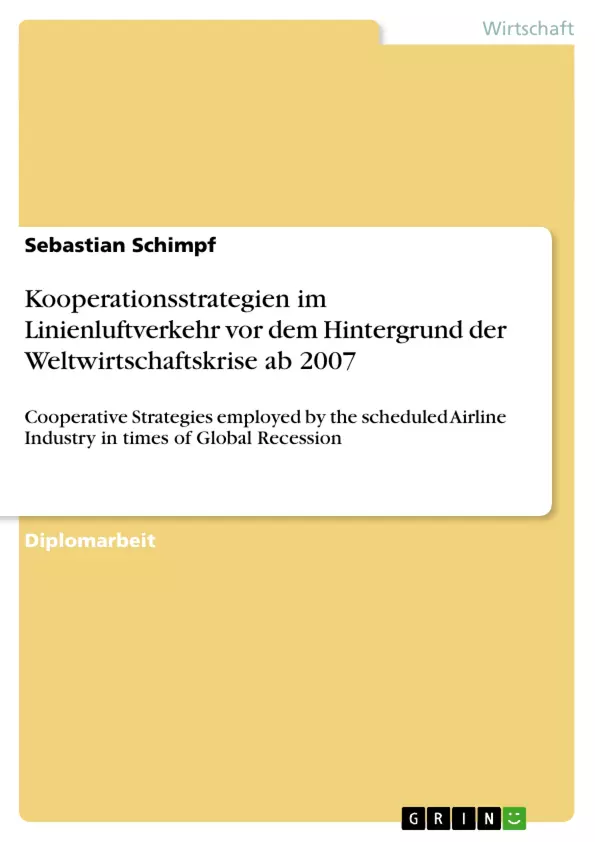Gegenstand des vorliegenden Werkes ist die Analyse zwischenbetrieblicher Kooperationsbeziehungen im internationalen Linienluftverkehr. Dazu werden, aufbauend auf wissenschaftlich fundierten Grundlagen zur Kooperationstheorie, die historische Entwicklung und das rechtlich-institutionelle Umsystem im Luftverkehr dargestellt, um fortfolgend Kooperationsstrategien entsprechend einordnen und das mögliche Potential interorganisationaler Zusammenarbeit gebührend würdigen zu können. Im Anschluss erfolgt die Untersuchung des Ausmaßes und der Auswirkungen der weltweiten Wirtschaftskrise ab 2007 auf den Luftverkehr, die abschließend dazu dient, die Theorie kooperativer Arrangements durch ihre praktische Anwendung in Krisenzeiten zu legitimieren und ihr Substanz und Nachhaltigkeit zu bescheinigen.
Inhaltsverzeichnis
- Kurzfassung
- Abstract
- Inhaltsverzeichnis
- Abbildungsverzeichnis
- Tabellenverzeichnis
- Abkürzungsverzeichnis
- 1. Einleitung
- 1.1 Ziele, Herausforderungen und Aktualität der Arbeit
- 1.2 Aufbau der Arbeit und Vorgehensweise
- 2. Gegenstand der Arbeit
- 2.1 Luftverkehrsbranche
- 2.2 Fluggesellschaften
- 2.2.1 Geschäftsmodelle von Fluggesellschaften
- 2.2.2 Das Produkt im Linienluftverkehr und seine Besonderheiten
- 2.3 Weltwirtschaftskrise ab 2007
- 2.4 Themenabgrenzung
- 3. Theoretische Grundlagen
- 3.1 Strategiebegriff und strategische Ausgangslage
- 3.2 Koordinationstheorie zur Einordnung von Kooperationen zwischen Markt und Hierarchie
- 3.2.1 Transaktionskostentheorie
- 3.2.2 Koordinationsformen
- 3.2.3 Hybride Koordination – Netzwerktypen
- 3.2.4 Kritik an der Transaktionskostentheorie
- 3.3 Klärung des Kooperationsbegriffes
- 3.3.1 Begriffsdefinition: Kooperation
- 3.3.2 Rivalen als Partner: Co-opetition
- 3.3.3 Bedeutung der Kooperationsstrategie im Zielsystem eines Unternehmens
- 3.4 Ursachen, Motive und Risiken von Kooperationen
Zielsetzung und Themenschwerpunkte
Diese Diplomarbeit analysiert die zwischenbetrieblichen Kooperationsbeziehungen im internationalen Linienluftverkehr. Aufbauend auf wissenschaftlichen Grundlagen zur Kooperationstheorie werden die historische Entwicklung und das rechtlich-institutionelle Umfeld des Luftverkehrs beleuchtet, um Kooperationsstrategien einordnen und das Potential interorganisationaler Zusammenarbeit zu würdigen. Die Arbeit untersucht anschließend die Auswirkungen der weltweiten Wirtschaftskrise ab 2007 auf den Luftverkehr, um die Theorie kooperativer Arrangements durch ihre praktische Anwendung in Krisenzeiten zu legitimieren und ihre Nachhaltigkeit zu belegen.
- Analyse der Kooperationsstrategien im internationalen Linienluftverkehr
- Einordnung von Kooperationsstrategien im Kontext der historischen Entwicklung und des rechtlich-institutionellen Umfelds des Luftverkehrs
- Bewertung des Potenzials interorganisationaler Zusammenarbeit im Luftverkehr
- Untersuchung der Auswirkungen der Weltwirtschaftskrise ab 2007 auf den Luftverkehr
- Legitimierung kooperativer Arrangements als nachhaltige Unternehmensführung in Zeiten globaler Rezession
Zusammenfassung der Kapitel
Kapitel 1 führt in die Thematik der Diplomarbeit ein und erläutert die Ziele, Herausforderungen und Aktualität der Arbeit. Es wird der Aufbau der Arbeit und die Vorgehensweise beschrieben.
Kapitel 2 stellt den Gegenstand der Arbeit vor und beschreibt die Luftverkehrsbranche, Fluggesellschaften, ihre Geschäftsmodelle und das Produkt im Linienluftverkehr. Weiterhin wird die Weltwirtschaftskrise ab 2007 beleuchtet und die Themenabgrenzung der Arbeit definiert.
Kapitel 3 befasst sich mit den theoretischen Grundlagen der Arbeit. Es werden der Strategiebegriff und die strategische Ausgangslage erläutert. Die Koordinationstheorie wird vorgestellt, um Kooperationen zwischen Markt und Hierarchie einzuordnen. Die Transaktionskostentheorie und Koordinationsformen werden analysiert, und hybride Koordinationsformen sowie Netzwerktypen werden vorgestellt. Die Kritik an der Transaktionskostentheorie wird diskutiert. Der Kooperationsbegriff wird geklärt, und die Bedeutung der Kooperationsstrategie im Zielsystem eines Unternehmens wird untersucht.
Schlüsselwörter
Die Arbeit konzentriert sich auf die Themen Luftverkehr, Strategie, Kooperation und Wirtschaftskrise. Sie untersucht die Bedeutung von Kooperationsstrategien für die Fluggesellschaften in Zeiten globaler Rezession und analysiert die Auswirkungen der Weltwirtschaftskrise ab 2007 auf die Branche. Die Arbeit beleuchtet die verschiedenen Formen der Kooperation im Luftverkehr, die Motive und Risiken von Kooperationen sowie die Rolle von Transaktionskosten und Koordinationsformen.
- Quote paper
- Dipl. Betriebswirt (FH) Sebastian Schimpf (Author), 2010, Kooperationsstrategien im Linienluftverkehr vor dem Hintergrund der Weltwirtschaftskrise ab 2007, Munich, GRIN Verlag, https://www.grin.com/document/166898



